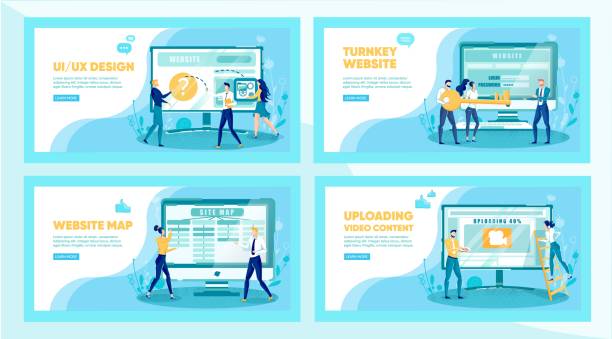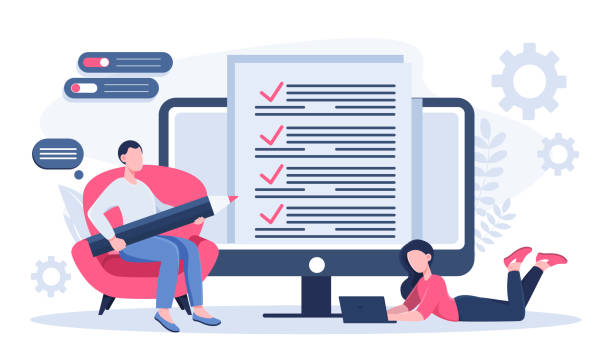Introduction to Responsive Web Design

In today’s world, where various devices with diverse screen sizes, from smartphones and tablets to laptops and televisions, are used to access the internet, the importance of flexible and #adaptable #web_design for all these platforms is felt more than ever.
This is where the concept of Responsive Web Design enters the scene.
This approach means creating a website that can respond and adapt to the environment and device through which the user accesses the site.
The main goal of this type of design is to ensure an optimal and seamless user experience for all visitors, regardless of their screen size or device type.
With this design method, there is no longer a need to build separate versions for desktop, mobile, or tablet, which in itself leads to reduced costs and development time.
In fact, a single codebase can be displayed correctly across all devices.
This explanatory and educational aspect is the foundation of our understanding of why this technique is popular and necessary.
Are you worried that your old company website is scaring away new customers? Rasaweb solves this problem with modern and efficient corporate website design.
✅ Increases your brand’s credibility.
✅ Helps attract targeted customers.
⚡ Contact Rasaweb for a free consultation!
Why is Responsive Design Crucial? Advantages and Necessities

The question that arises is why a business should move towards responsive design? The answer lies in several key advantages that directly impact online success.
First, it’s #User_Experience (UX).
A website that displays well and is easy to use across all devices leads to greater user satisfaction and a reduction in Bounce Rate.
The second important advantage is its direct impact on #SEO (Search Engine Optimization).
Google has explicitly stated that it prefers responsive websites, and these websites achieve better rankings in mobile search results.
This is important news for any business that values online visibility.
Third, reduced maintenance and development costs; instead of managing multiple separate websites for each device, there is only one codebase, which saves time and resources.
This comprehensive analysis shows that responsive website design is not just a choice, but a strategic necessity for competing in today’s digital market, and it directly impacts #conversion_rates and return on investment.
Core Principles and Techniques of Responsive Website Design

To implement a responsive website, there are three fundamental principles that every developer must understand and apply: CSS3 #Media_Queries, #Fluid_Grids, and #Flexible_Images.
Media queries allow developers to apply different CSS styles based on device characteristics such as screen width, height, orientation, and resolution.
This powerful tool allows you to optimize your design for each device.
Fluid grids, instead of using fixed pixel units, use relative percentages to determine element widths, so the website layout automatically adjusts with screen size changes.
Flexible images follow the same logic; using CSS, image widths are adjusted so they never overflow their container, while maintaining their quality across different screen sizes.
These technical principles form the core of responsive website design and allow designers to have complete control over how content is displayed on various devices.
This specialized and educational section is the cornerstone of every successful adaptive design project.
| Feature | Description | Example (CSS) |
|---|---|---|
| Media Queries | Applying different styles based on device characteristics (e.g., screen width). | @media (max-width: 600px) { ... |
| Fluid Grids | Using relative units (percentages) for element widths instead of fixed units. | width: 50%; |
| Flexible Images | Adjusting image sizes to adapt to their container. | img { max-width: 100%; height: auto; } |
| Viewport Meta Tag | Setting the viewport scale for correct display on mobile devices. | <meta name="viewport" content="width=device-width, initial-scale=1.0"> |
Mobile-First vs. Desktop-First Approach

When designing a responsive website, there are two main approaches to start with: #Mobile-First and #Desktop-First.
In the more traditional Desktop-First approach, designers first design the website for large screens and then adapt it for smaller devices using media queries.
This method can lead to CSS bloat and poor performance on mobile, as desktop styles might be unnecessary on mobile and require overriding.
In contrast, the Mobile-First approach, which is highly recommended today, starts with designing for the smallest screen (mobile).
In this case, only essential styles for mobile are written first, and then, using media queries, features and layouts are progressively added for larger screens.
This approach ensures that the website loads faster and more efficiently on mobile devices, as only the necessary CSS for that device is loaded.
Mobile-First also helps designers focus on core content and site functionality, as screen space is limited.
This choice of approach is one of the most important decisions in the early stages of adaptive design and can significantly impact the final outcome and efficiency of the website.
This analytical and explanatory section is crucial for choosing the best path.
Does your current e-commerce website design lead to lost customers and sales?
Rasaweb is your solution with modern and user-friendly e-commerce website designs!
✅ Significant increase in conversion rates and sales
✅ Creating strong branding and gaining customer trust
⚡ Get a free e-commerce website design consultation from Rasaweb!
Popular Tools and Frameworks for Adaptive Design

To facilitate and accelerate the adaptive design process, numerous tools and frameworks have been developed that help designers and developers easily create responsive websites.
Among the most popular of these frameworks are #Bootstrap and #Foundation.
These frameworks provide a set of pre-built HTML, CSS, and JavaScript components that are designed from the ground up for #responsiveness.
By using them, complex and responsive layouts can be quickly implemented, significantly reducing development time.
In addition to frameworks, CSS preprocessors like #Sass and #LESS are also powerful tools that improve the process of writing CSS for responsive website design by adding features such as variables, functions, and nesting.
These tools help developers write cleaner, more maintainable, and more modular code.
Choosing the right tools depends on project needs and the development team, but familiarity with them is essential for anyone involved in responsive website design.
This guidance and educational section paves the way for choosing the right tools.
Testing and Debugging Responsive Websites
![]()
After designing and implementing a responsive website, the crucial stage of #testing and #debugging arrives.
This stage ensures that the website functions correctly across all devices and browsers and delivers the intended user experience.
Browser #Developer_Tools like Chrome DevTools, Firefox Developer Tools, and Safari Web Inspector offer built-in capabilities for simulating various screen sizes and mobile devices.
These tools allow you to quickly view how the website displays in different dimensions and identify and fix potential bugs, without needing a physical device.
However, simulation is not complete, and testing on real devices is of paramount importance.
Scrolling behavior, touch interactions, and overall performance on real devices might differ from simulators.
Furthermore, #browser_compatibility testing is also important, as each browser might interpret CSS and JavaScript standards slightly differently.
Using tools like BrowserStack or CrossBrowserTesting for testing across different environments is recommended.
The meticulous testing and debugging process transforms the website from a rough draft into a reliable final product and ensures that responsive website design has been correctly implemented.
This guidance and educational section covers the practical aspects.
Impact of Responsive Design on SEO and User Experience

Responsive design is not only important for #User_Experience, but also plays a vital role in #Search_Engine_Optimization (SEO).
Google adopted the Mobile-First Indexing approach years ago, meaning that for ranking websites, it considers the mobile version of your site as the primary version.
Therefore, if your website is not optimized for mobile, it may achieve a lower ranking in search results, and this is crucial and important news for business owners.
Responsive websites, by providing a single URL for all devices, prevent duplicate content issues and make crawling and indexing easier for search engines.
In addition to SEO, user experience also significantly improves.
When users can easily navigate your website on any device, the likelihood of them staying on the site, interacting with content, and performing desired actions (such as purchasing or signing up) increases.
This means reduced bounce rate and increased conversion rate.
In summary, responsive website design is a strategic investment that directly impacts your website’s visibility in search engines and the overall success of your online business.
This is a comprehensive analysis of its benefits.
| Advantage | Impact on SEO | Impact on User Experience (UX) |
|---|---|---|
| Single URL | Prevents duplicate content, makes crawling and indexing easier for Google. | Easier link sharing and reduced user confusion. |
| Mobile Optimization | Better ranking in mobile search results (due to Mobile-First Indexing). | Easy access, high readability, and smooth navigation on mobile. |
| Loading Speed | High speed is an important ranking factor in Google. | Users have a faster and more pleasant experience, reduced bounce rate. |
| Conversion Rate | Increased user engagement and retention, indirectly improving SEO. | Ease of performing desired actions such as purchase, registration, or contact. |
Common Challenges and Solutions in Adaptive Design

Despite its numerous benefits, adaptive design can also bring challenges.
One of the biggest challenges is #Performance_Optimization.
Although the goal of responsive website design is to provide a seamless experience, loading high-resolution images and complex scripts for mobile devices with slow internet can lead to a slow website.
The solution to this problem is to use techniques such as Lazy Loading for images, code minification, and font optimization.
Another challenge is managing #complex_layouts.
Transforming a complex desktop layout into a simple and usable mobile layout without losing information or usability requires creativity and precise planning.
Using modular components and a mobile-first approach can be helpful in this regard.
Also, supporting older browsers is a concern; some older browsers may not support all the CSS3 features required for responsive website design.
In these cases, using Polyfills or Fallbacks can be a solution.
The questionable content here is how to strike a balance between advanced features and broad accessibility? The answer lies in continuous testing, ongoing optimization, and prioritizing user needs.
These guidelines help overcome common problems.
Does your current website build the trust that potential customers should have in your business? If the answer is no, it’s time to have a professional and impactful corporate website with Rasaweb.
✅ Fully customized design tailored to your brand identity
✅ Increased lead generation and business credibility in the eyes of customers⚡ Contact us for a free consultation!
Future Trends in Responsive Website Design

The world of web design is constantly changing and evolving, and responsive website design is no exception.
Future trends indicate that the focus on personalized and intelligent user experience will become increasingly important.
One important trend is #Progressive_Web_Apps (PWAs), which offer a combination of the best features of web and native applications.
PWAs can work offline, send notifications, and even be installed on the mobile home screen, which significantly improves the user experience.
Also, #Artificial_Intelligence (AI) and Machine Learning will play a more prominent role in web design, from generating user interfaces based on data to automatically optimizing content for different devices.
The emergence of #Virtual_Reality (VR) and #Augmented_Reality (AR) can also create new challenges and opportunities for responsive design, where websites must be able to adapt to 3D and interactive environments.
The intriguing content here is how these technologies can take the user experience to an entirely new level, and whether current designs are ready for this future? This news and analytical section offers a look at new horizons in this field.
Conclusion and Best Practices for Responsive Website Design

Ultimately, it can be said that responsive website design is no longer a luxury option, but an absolute necessity for any business or individual who wants to succeed in today’s digital world.
From improved user experience and SEO to reduced development and maintenance costs, its benefits are countless.
To ensure successful implementation of adaptive design, follow best practices: always start with a #Mobile-First approach to optimize the core content and functionality for small devices.
Use #media_queries correctly and use relative units (such as percentages or em/rem) instead of fixed pixels for #fluid_grids and #flexible_images.
Don’t forget thorough and continuous testing on real devices and various browsers.
Pay special attention to #Performance_Optimization to ensure your website is fast on all devices.
By following these #best_practices, you can ensure that your website not only meets current user needs but is also prepared for the #future_of_web and upcoming technological changes.
This comprehensive training and guidance provides a clear path for every developer or website owner.
Frequently Asked Questions
| Question | Answer |
|---|---|
| What is Responsive Web Design? | A method of website design that ensures the website displays well across various screen sizes and devices (such as mobile, tablet, desktop) and provides an appropriate user experience. |
| Why is responsive design important? | Improved user experience, better SEO (Google prefers responsive sites), saving time and cost (no need to build separate sites for mobile). |
| What are the main techniques in responsive design? | Using flexible grids and layouts (Fluid Grid), flexible images and media (Flexible Images), and using Media Queries in CSS. |
| What are Media Queries in responsive design? | A part of CSS3 that allows you to apply different styles based on the characteristics of the device on which the website is displayed (such as screen width, resolution, media type). |
| What are the advantages of using responsive design? | Access to more users (especially mobile), improved user engagement rate, reduced maintenance costs (one site for all devices), and improved Conversion Rate. |
And other advertising services by Rasaweb Advertising Agency
- Smart Social Media: A combination of creativity and technology for online growth through the use of real data.
- Smart Conversion Rate Optimization: Designed for businesses looking to attract customers through user experience customization.
- Smart Advertorial: A combination of creativity and technology for digital branding through intelligent data analysis.
- Smart Social Media: A professional solution for digital branding with a focus on optimizing key pages.
- Smart Link Building: Designed for businesses looking to increase sales through precise audience targeting.
And over hundreds of other services in the field of internet advertising, advertising consulting, and organizational solutions
Internet Advertising | Advertising Strategy | Advertorial
Resources
Comprehensive Guide to Responsive Design on Webramz
Principles of Responsive Website Design on Iran ICT
Mobile-First Design Tutorial on Site Design
Why Responsive Design Matters? (Parsa Data)
? Rasaweb Afarin: Your digital partner for growth and visibility in the online world. From custom website design to SEO optimization, we offer comprehensive solutions for your business success.
📍 Tehran, Mirdamad Street, next to Bank Markazi, Southern Kazeroon Alley, Ramin Alley, No. 6

